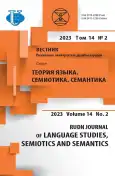Re-thinking Semiotics: a New Categorization of a Sign?
- Авторлар: Shilina M.G.1,2, Zarifian M.3
-
Мекемелер:
- Plekhanov Russian University of Economics
- Lomonosov Moscow State University
- RUDN University
- Шығарылым: Том 14, № 2 (2023)
- Беттер: 305-313
- Бөлім: SEMANTICS AND SEMIOTICS
- URL: https://journal-vniispk.ru/2313-2299/article/view/323430
- DOI: https://doi.org/10.22363/2313-2299-2023-14-2-305-313
- EDN: https://elibrary.ru/LVEYJG
- ID: 323430
Дәйексөз келтіру
Толық мәтін
Аннотация
The study discusses the fundamental issues of semiotics. Semiotics still involves no broadly agreed upon theoretical assumptions, models, or empirical methodologies. Faced with much disagreement among notable semioticians about what semiotics actually entails, the study opens up the way to its theoretical re-thinking. Starting from the analysis of the discussions of scientists it indicated that the signs are not identical to what they represent this studies the issue through a theoretical concepts analysis, literature review, combined with comparative analysis of the main classical theoretical parameters of signs. The basic approach of this study is that signs, whether it is symbolic, iconic, or indexical, are not what they mean. The nature of the sign, whether it is symbolic, iconic, or indexical, determines the way it is used, and the same signifier can be used in different ways in different contexts. The role of an interpreter should be taken into account. A sign meaning is not inherent in it; rather, it is determined by how it is interpreted. The relevance of the research is due to a new complex approach to statements about users, signs or referents that could never be made in isolation from each other. A statement about one of those always contains implications about the other two. Rather than specific «types of sign», we're talking about symbolic, iconic, and indexical forms of relationships. The hypothesis is as follows: the nature of the sign determines the way it is used. Moreover, the same signifier can be used both iconically and symbolically in different contexts. The novelty of the research is related to the idea of the sign that can be interpreted in different ways depending on who observes it: as symbolic, iconic or indexical. In other words, signs cannot be classified according to the classical semiology canons, but only with regard to the goals of their users and a certain context. Regarding this, we will propose a comparative analysis of the classic models of the sign to prove the hypothesis. The hypothesis is proved due to the provided comparative analysis of the classic models of a sign and modes of its relationship. The findings of this study have to be seen in light of some major limitations. First, the main primary research problem we have to solve was the semiotics of contemporary cartoons. Facing the lack of previous research studies and the theoretical foundations for the research on the topic, we decided that prior theoretical research studies that are relevant to our specific topic are needed, which is why the article is aimed at theoretical issues. Theoretical and methodological limitations are addressed to our future studies. The research instruments and techniques used to collect the empirical data will have to be identified. Intercultural specifics connected with the personalities of the authors - Russian and Iranian researchers - influence the study but also limits it.
Авторлар туралы
Marina Shilina
Plekhanov Russian University of Economics; Lomonosov Moscow State University
Хат алмасуға жауапты Автор.
Email: marina.shilina@gmail.com
ORCID iD: 0000-0002-9608-352X
Scopus Author ID: 57196371205
ResearcherId: U-4481-2018
Dr.Sc. (Philology), Professor of the Department of Advertising, PR and Design, Plekhanov Russian State University of Economics; Assistant Professor of the Department of Advertising and PR, Faculty of Journalism, Lomonosov Moscow State University
9, Mokhovaya str., Moscow, Russian Federation, 125009Mohsen Zarifian
RUDN University
Email: mohsen.zarifian@gmail.com
ORCID iD: 0000-0001-7363-0263
PhD student in international journalism; Assistant of the Department of Mass Communication, Philological Faculty
6, Miklukho-Maklaya str., Moscow, Russian Federation, 117198Әдебиет тізімі
- Eco, U. (1976). A Theory of Semiotics. Bloomington: IN: Indiana University Press/London: Macmillan.
- Culler, J. (1975). Structuralist Poetics: Structuralism, Linguistics and the Study of Literature. London: Routledge & Kegan Paul.
- Saussure, F. de. (1983). Course in General Linguistics. London: Duckworth.
- Peirce, Ch.S. (1931-1958). Collected Writings in 8 Vols. Cambridge, MA: Harvard University Press.
- Langer, S.K. (1951). Philosophy in a New Key: A Study in the Symbolism of Reason, Rite, and Art. New York: Mentor.
- Saussure, F. de. (1974). Course in General Linguistics. London: Fontana/Collins.
- Jakobson, R. (1963). Visual and Auditory Signs. In: Selected Writings. The Hague: Mouton. pp. 334-337.
- Sless, D. (1986). In Search of Semiotics. London: Croom Helm.
- Thibault, P.J. (1997). Re-reading Saussure: The Dynamics of Signs in Social Life. London: Routledge.
- Hawkes, T. (1977). Structuralism and Semiotics. London: Methuen.
- Bruss, E.W. (1978). Peirce and Jakobson on the Nature of the Sign. In: Bailey, R.W., Matejka, L. and Steiner, P. (eds.) The Sign: Semiotics Around the World. MI: University of Michigan Press. pp. 81-98.
- Lyons, J. (1977). Semantics. Vol. 1. Cambridge: Cambridge University Press.
- Grayson, K. (1998). The I cons of Consumer Research. Using Signs to Represent Consumers' Reality. In: Representing Consumers. Abingdon: Taylor and Francis. pp. 27-43. 10.4324/9780203380260-8
- Coward, R. & Ellis, J. (1977). Language and Materialism: Developments in Semiology and the Theory of the Subject. London: Routledge & Kegan Paul.
Қосымша файлдар









